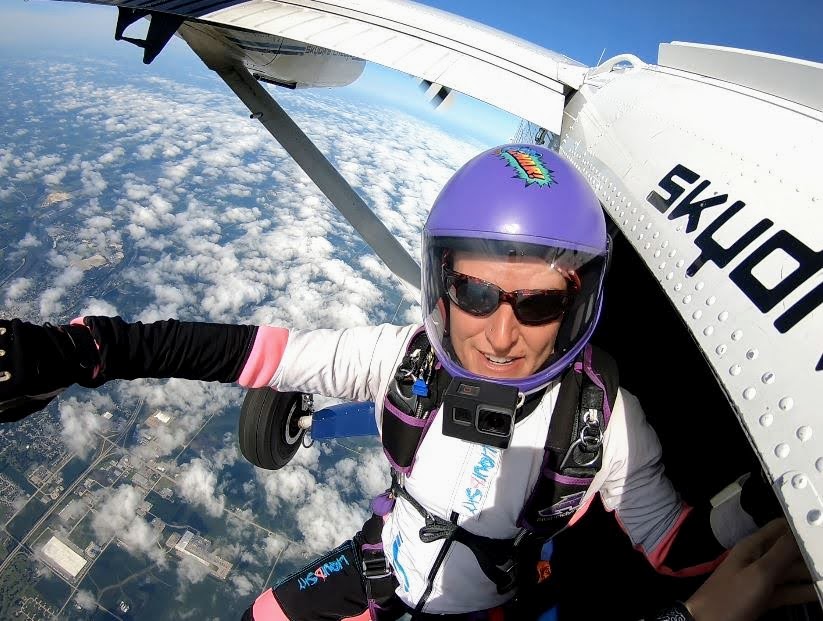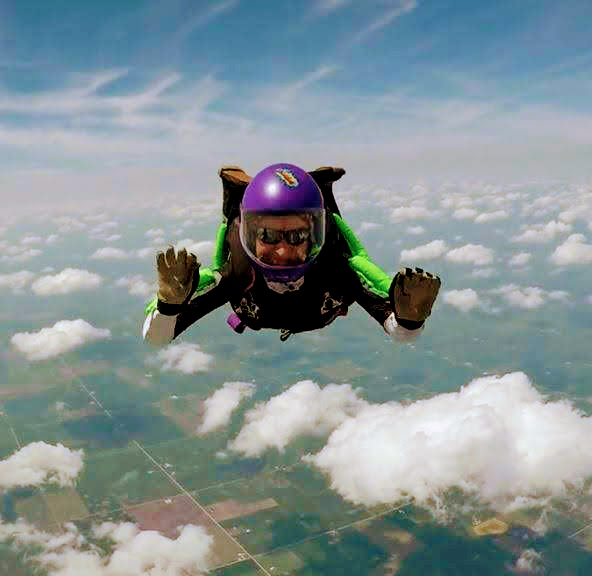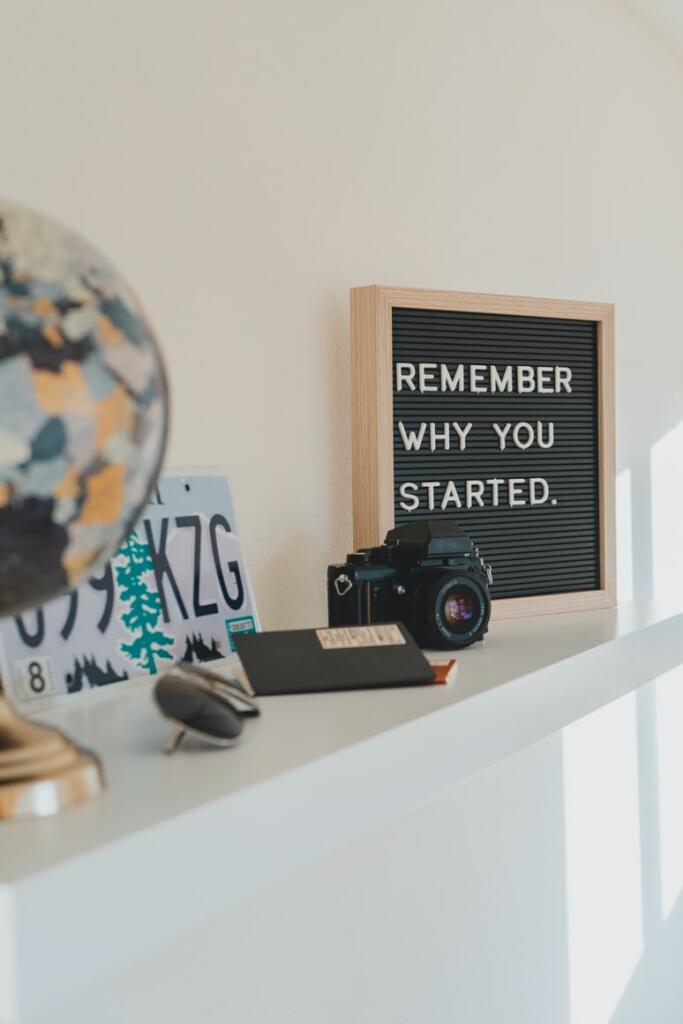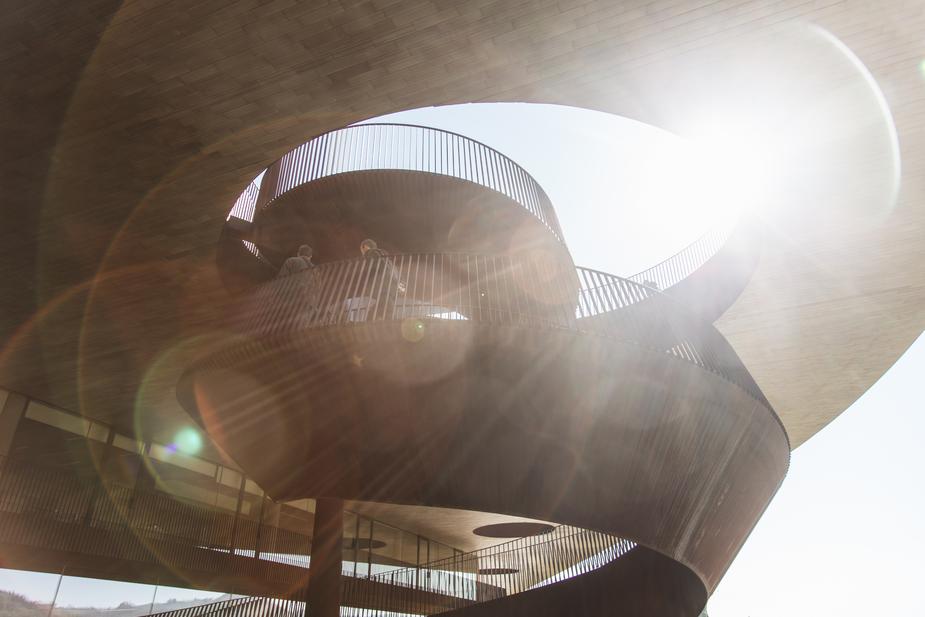Red light.
I shuffle on my knees towards the open plane door. It’s a hot summer day, and when I stick my head out, I appreciate the instant air conditioning I get from the plane propeller. I spot a few white fluffy clouds in the distance, a bit below us. I look for the usual landmarks – the Fox River to the east, the big Kohl’s box store to the west, highway and town to the south, and the rock quarry to the north. It’s important to recognize these features since spotting the dropzone from 14,000 feet can be a challenge if you get disoriented.
My eyes lock on to our target landing area, and I know that we’re set up for a good run. I turn to my jump partner and give a thumbs up. We wait patiently for our signal to go – green light. We click shut the face of our helmets and get into position. I climb out the door, keeping hold of the metal bar inside the plane. My partner grabs my arms, shakes them hard which means “I’m ready!”, and then we begin our dance. I swing my left leg out (“Ready!”), then in (“Set!”), and out we jump.

Hi, I’m Dallas. I’m a veterinarian, an epidemiologist, and (as you’ve probably gathered) a skydiver. My career has navigated health issues of two-legged, four-legged, and winged varieties of species: I’ve interviewed poultry farmers in British Columbia (Canada) during an outbreak of highly pathogenic avian influenza. I’ve designed and implemented checklists for physicians to use in Saskatchewan to increase timely access to MRIs for those in need. I provided field epidemiology assistance for an outbreak of Tuberculosis in an underhoused community, and helped to develop a national surveillance system for animal rabies in Canada. And I’m about to head overseas to help inform policy decisions regarding biosecurity in response to an outbreak in cattle in New Zealand.
I’ve had the privilege of being involved in exciting and interesting projects in my first four years out of grad school. While academic achievements helped me qualify for these jobs, I believe that many of the skills I learned outside of school in extracurricular activities let me land these roles and ultimately succeed at them. One of my favourite examples of this is skydiving. I believe becoming a skydiver has played a key part in my professional success.
Most people think of skydiving in terms of doing a tandem jump – where you are strapped to the front of a Tandem Master as you leave the plane. This is a great way to be introduced to the sport, but after one or two of these you’ll be itching to take the next step. As a sport skydiver, you are taught to wear and open your own parachute. You can then begin to train, and even compete in, different skydiving disciplines as you advance in skill. Think of skiing – there is alpine, cross country, ski jumping, Nordic combined, and freestyle. Similarly, skydivers may choose to participate in disciplines such as relative work (falling belly to ground orientation, making different formations in the sky with other jumpers), freefly (falling head down or in sit orientation), wingsuiting (wearing one of those squirrel suits), or canopy work (accuracy-style performance while landing your parachute). I love the precision of relative work and am slowly getting better at holding a sit position for freefly.
It’s unlikely I’ll be able to transfer skydiving-specific skills to my public health career, until the day someone needs me to parachute in somewhere. However, the general lessons I’ve mastered in this sport have provided me with tremendous personal and professional growth that shines through in my work. Here are a few examples, and hopefully you can reflect on ways these tools might be useful in your own career:
Slow is Fast
In skydiving, we use the expression “Slow is Fast.” It speaks to the idea that doing important tasks slowly and methodically can often be faster in the end than rushing and making mistakes. Mistakes at best can take more time to fix, and at worst might make a situation disastrous. We do many checks of our skydiving equipment, but the most stressful gear check is on “Jump run” just a few minutes before we leave the plane. We are taught to use breathing exercises to slow our heart rate and stay focused, while our hands slowly and methodically touch and check all our life-saving gear. Even under the pressure of being minutes away from jumping out of a plane, the importance of being slow and methodical pays off. Get it right the first time.
Is this a real emergency?
Skydiver training focuses a lot on how to recognize, and then fix, a malfunctioning parachute. We hang in practice harnesses and look up at computer screens simulating a canopy above our head.
“The lines are all twisted! Is this an emergency?” (No!)
“What do you do?” (Hold the lines together and kick until they untwist)
“Your parachute is a tangled mess above your head! Is this an emergency” (Yes!)
“What do you do? (Cut that parachute away and go to your backup parachute)
It is critical that we can quickly recognize real emergencies and know what to do. But just as importantly, we need to know when a situation is just an inconvenience so we can respond appropriately with calm, collected thought; no sense getting worked up over something that probably won’t kill you. Take a deep breath, and don’t make something into a bigger deal than it needs to be.
Practice makes perfect
Before getting on a plane for a jump, skydivers often go through a lot of mental preparation and physical practice. We discuss the plan with others on the jump and do a dry run in the hangar before gearing up. At the 10-minute call, we put on our parachutes, helmets and altimeters before heading outside to “dirt dive”. A dirt dive is where we practice the entire jump starting from the exit out of the door, using a life-sized plane mock-up. And finally, we visualize the entire jump beginning to end during the ride up to altitude, seeing it go perfectly in our minds.
I’ll be honest, I’ve been on jumps where for various reasons we had to throw our gear on and run to the plane with very little practice of the upcoming jump. While still fun, those jumps rarely helped improve my skill or complete any of my skydiving goals. Skydiving is not a cheap sport, and it makes a lot more sense to work out the kinks on the ground rather than figure them out in the air. Practice before the real thing, if you can.
Make a plan, but be prepared for everything to change
We spend a lot of time planning in skydiving to stay safe. Like choosing break-off, which is the altitude we end the freefall part of our jump, separate from each other, and prepare to open our parachutes. Or, deciding at what altitude we will deploy our parachute, making sure there will still be plenty of distance between us and the ground by the time it opens. Even agreeing on what direction all twenty skydivers on the plane will land, so that there aren’t any collisions as we make our way to the ground.
But things change. A jumper falls beneath your group, creating a dangerous situation if they open their parachute and collide with others in freefall. You reach back to open your parachute but can’t pull the handle out that starts the sequence. You find out when you’re under your canopy that the wind direction has changed, making the chosen landing direction downwind (which makes for a very fast, and scary, landing).
Building the resiliency needed to quickly respond to changes in the plan helps to keep skydivers alive. Think on your feet and be adaptable to changing circumstances.
I am so grateful for the education I gained in school, which of course is important for our careers. But I strongly believe that we need diverse life experiences out of the classroom to integrate that knowledge meaningfully in our jobs. I’m not saying you need to become a skydiver (though of course I highly recommend it), but I encourage you to be creative in your extracurricular pursuits and recognize that they may be contributing to your professional life more than you think.







